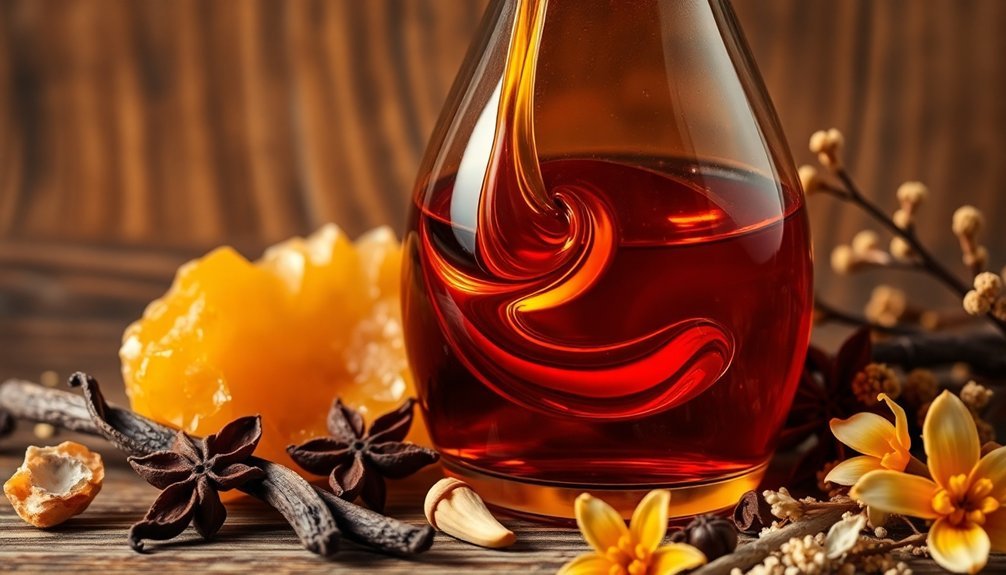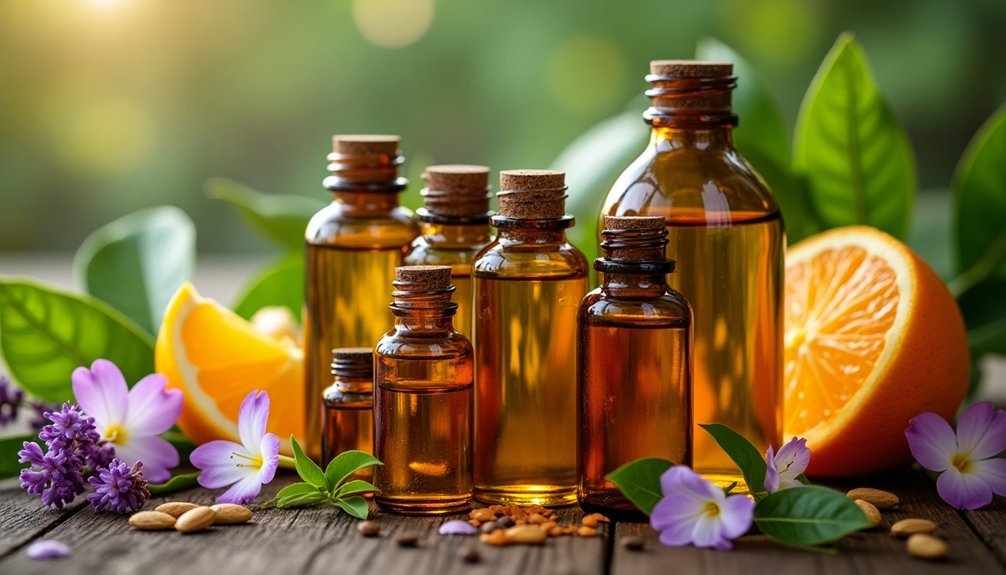When creating DIY perfumes, you'll find amber, fresh floral, and fougère families offer the most versatile foundation for blending. Amber brings warmth through vanilla and resins, while fresh florals combine citrus top notes with botanical hearts for an uplifting effect. The classic fougère structure balances lavender, oakmoss, and coumarin for timeless appeal. Understanding these three families will reveal countless possibilities for crafting your signature scents.
The Amber Family: Rich Depth for Artisanal Perfumes

Warmth and sophistication define the amber family of fragrances, making them a cornerstone of artisanal perfumery. When you're creating amber-based perfumes, you'll work with a rich palette of vanilla, resins, and synthetic musks to achieve that signature cozy, sweet allure.
You can explore three main sub-categories: classic amber with its citrus and vanilla notes, woody amber featuring sandalwood and patchouli, or spicy amber incorporating clove and cardamom. The addition of benzoin and labdanum creates the characteristic amber accord that gives this family its distinct identity.
To blend your own amber perfume, start with the drop-by-drop method using a 3:2:1 ratio of base, middle, and top notes.
Remember to include fixative elements like myrrh to guarantee longevity. Whether you're aiming for a gentle, soothing scent or a more seductive composition, amber's versatility lets you craft perfumes that evolve beautifully on the skin.
Fresh Floral Notes: Building Beautiful Botanical Blends
Creating fresh floral perfumes requires a delicate balance between light, bright notes and deeper botanical elements.
You'll want to start with citrus and green top notes to establish an immediate freshness, then layer in your chosen florals like rose, jasmine, or lily of the valley for the heart of your blend. The Fragrance Wheel helps perfumers systematically select complementary notes that work well together.
To craft a memorable fresh floral scent, consider these essential combinations:
- Bergamot and neroli top notes with jasmine sambac middle notes for an uplifting, feminine blend
- Green herbaceous notes paired with powdery florals for a natural, airy feeling
- Sea salt accents combined with light fruity notes to create a modern, fresh impression
Ground your creation with subtle base notes like cashmere wood or vanilla bean to guarantee longevity without overpowering the delicate floral elements.
Classic Fougère: Crafting Nature's Perfect Balance

The timeless fougère accord stands as one of perfumery's most influential compositions, blending lavender's aromatic brightness with earthy oakmoss and warm coumarin notes.
When crafting your own fougère blend, start with these core elements and build outward. Layer bergamot in the top notes for citrusy freshness, then add geranium at the heart for floral complexity. The original Fougère Royale by Houbigant pioneered this revolutionary accord in 1882.
You'll find the structure remarkably versatile – you can modernize it by incorporating unexpected elements like black pepper or grapefruit while maintaining the classic framework.
The key is balancing the fresh aromatic top, floral heart, and mossy base. Consider experimenting with additional herbaceous notes like rosemary or thyme, or explore woody variations with vetiver.
This tried-and-true formula's adaptability makes it perfect for both traditional masculine scents and contemporary unisex interpretations.
Frequently Asked Questions
How Long Should Perfume Blends Mature Before Testing Their Final Scent?
You'll need to let your perfume blend mature for at least 2-3 weeks, though complex fragrances may require several months. For a quick assessment, you can test after one week of aging.
Can Essential Oils Be Substituted for Synthetic Fragrance Notes?
You can't directly substitute essential oils for synthetic fragrances due to their different chemical compositions. While you'll get similar scents, they'll have varying intensities, longevity, and performance in your final blend.
What's the Ideal Room Temperature for Storing Blended Perfumes?
You'll want to store your blended perfumes at a steady 60-70°F (15-21°C). Keep them in a cool, dark place away from windows and heat sources to maintain their quality and prevent fragrance degradation.
How Do Seasonal Temperature Changes Affect Perfume Blending Ratios?
You'll need to adjust your blending ratios seasonally – use more top notes in winter (4:2:1) for better projection, and lighter ratios in summer (3:2:1) to prevent overwhelming scents in high temperatures.
Should Different Application Methods Alter the Concentration of Fragrance Notes?
Yes, you'll need to adjust your fragrance concentrations based on how you apply them. Spraying requires higher concentrations, while roll-ons and primers need lower amounts to achieve the same scent impact.
In Summary
You've now explored three cornerstone perfume families that'll serve as your foundation for DIY fragrance creation. Whether you're drawn to amber's warm embrace, fresh florals' delicate beauty, or fougère's timeless harmony, you're equipped to start blending your signature scents. Remember to trust your nose, experiment with proportions, and keep detailed notes of your successful combinations. Your perfume-making journey is just beginning.





Leave a Reply